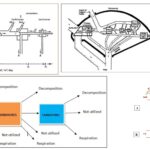Botany 38 Views 1 Answers
Sourav PanLv 9September 14, 2024
Differentiate between the following: Haploids and Monoploids Double Trisomic and Tetrasomic Homologous and Homoeologous Chromosomes Autopolyploid and Allopolyploid Diploid and Diploidized Species Aneuploid and Euploid Polyploidy and Heteroploidy
Differentiate between the following:
- Haploids and Monoploids
- Double Trisomic and Tetrasomic
- Homologous and Homoeologous Chromosomes
- Autopolyploid and Allopolyploid
- Diploid and Diploidized Species
- Aneuploid and Euploid
- Polyploidy and Heteroploidy
Please login to save the post
4
Please login to submit an answer.
Sourav PanLv 9May 15, 2025
Differentiate between the following:
(i) Haploids and Monoploids
- Haploids: Haploids are organisms or cells that contain only one complete set of chromosomes, represented as nnn. In the context of diploid organisms, haploids arise through meiosis and include gametes such as sperm and eggs. Haploids have half the chromosome number of the diploid parent and are essential for sexual reproduction.
- Monoploids: Monoploids refer to organisms or cells that also have a single set of chromosomes, but this term is often used in contexts where diploidy is the norm. Monoploids can occur naturally in some species or be produced artificially, especially in plant breeding. They are particularly useful in genetic studies and mutation breeding.
(ii) Double Trisomic and Tetrasomic
- Double Trisomic: A double trisomic organism has two additional chromosomes, each from different chromosome pairs, resulting in a total of 2n+1+12n + 1 + 12n+1+1 chromosomes. This means there are two extra chromosomes in addition to the normal number.
- Tetrasomic: A tetrasomic organism has an additional pair of chromosomes, resulting in 2n+22n + 22n+2 chromosomes. This means that there is one extra pair of chromosomes in addition to the normal number.
(iii) Homologous and Homoeologous Chromosomes
- Homologous Chromosomes: Homologous chromosomes are pairs of chromosomes in a diploid organism that have the same genes at the same loci but may have different alleles. One chromosome in each homologous pair is inherited from each parent.
- Homoeologous Chromosomes: Homoeologous chromosomes are chromosomes from different species or different genomes within a species that are similar in structure and function but not completely identical. They are often seen in allopolyploids where chromosomes from different species are involved.
(iv) Autopolyploid and Allopolyploid
- Autopolyploid: An autopolyploid organism has multiple sets of chromosomes derived from a single species. This occurs through the duplication of the entire genome within the same species. Examples include tetraploid potatoes that originate from a diploid ancestor.
- Allopolyploid: An allopolyploid organism has multiple sets of chromosomes derived from two or more different species. This results from hybridization between different species followed by chromosome doubling. Examples include hexaploid wheat, which results from hybridization between three different species.
(v) Diploid and Diploidized Species
- Diploid: A diploid organism has two complete sets of chromosomes, one from each parent. This is the typical chromosome number for most eukaryotic organisms.
- Diploidized Species: Diploidized species refer to organisms that originally had a higher ploidy level (such as polyploids) but have evolved or been bred to have a diploid-like chromosome number, often through chromosomal rearrangements or reductions. These species maintain some characteristics of polyploidy while functioning as diploids.
(vi) Aneuploid and Euploid
- Aneuploid: An aneuploid organism has an abnormal number of chromosomes that is not an exact multiple of the basic chromosome set. This can involve either the gain or loss of one or more chromosomes but not a complete set. Examples include monosomics (missing one chromosome) or trisomics (having one extra chromosome).
- Euploid: A euploid organism has a chromosome number that is an exact multiple of the basic chromosome set. This includes haploids, diploids, triploids, tetraploids, and other higher levels of ploidy. Euploidy represents a balanced chromosome set in terms of multiples.
(vii) Polyploidy and Heteroploidy
- Polyploidy: Polyploidy refers to the condition in which an organism has more than two complete sets of chromosomes. It includes various forms such as triploidy (three sets), tetraploidy (four sets), and higher levels. Polyploidy can arise naturally or be induced and is common in plants.
- Heteroploidy: Heteroploidy refers to the condition of having different or varied levels of ploidy within an organism or between individuals of a species. It encompasses variations in chromosome numbers that do not conform strictly to the typical euploid series, such as aneuploidy or deviations from the normal ploidy level.
0
0 likes
- Share on Facebook
- Share on Twitter
- Share on LinkedIn
0 found this helpful out of 0 votes
Helpful: 0%
Helpful: 0%
Was this page helpful?




